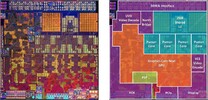
Toshiba Satellite C70D-B-10X Notebook Review Update
AMD A4-6210 | AMD Radeon R3 (Mullins/Beema) | 17.30" | 2.7 kg

The AMD A4-6210 is a mobile quad-core SoC (codenamed "Beema") for entry-level devices and subnotebooks, which has been presented in April 2014. In addition to 4 CPU cores clocked at up to 1.8 GHz (no boost), the 28 nanometer chip also integrates a Radeon R3 GPU, a single-channel DDR3L-1600 memory controller and the Southbridge with various I/O-ports.
Architecture
Both Beema (for notebooks) and Mullins (for tablets and compact subnotebooks, same die) are based on AMD's Puma+ architecture, which is the successor to the previous Jaguar design (Kabini and Temash APUs). Neither the performance per clock nor the feature set (including SSE up to 4.2, AVX and AES) have been modified. However, AMD managed to reduce the leakage current, enabling significantly higher (boost) clock speeds. This leads to a more responsive system and better overall performance. As its predecessor, the chip is manufactured in 28 nm.
Performance
According to the clock rate, the APU is clearly faster than the former A4-5000 (15 W, 1.5 GHz), but somewhat slower than the A6-5200 (25 W, 2.0 GHz). Nonetheless, the A4-6210 will be sufficient for all daily workloads like Office, Internet browsing and multimedia.
Graphics
The SoC integrates a Radeon R3 GPU with 128 shaders, which is based on the GCN architecture and clocked at up to 600 MHz. On average, we expect the graphics performance to be similar to Intel's HD Graphics 4000 (ULV versions) or a Radeon HD 8400. Current games (as of 2014) are thus hardly playable even in low settings, but some older and less demanding titels will run flawless.
Power Consumption
The power consumption of the entire SoC is rated at 15 watts. Thus, the APU is suitable for smaller subnotebooks.
| Codename | Beema | ||||||||||||
| Series | AMD AMD A-Series | ||||||||||||
Series: AMD A-Series Beema
| |||||||||||||
| Clock Rate | 1800 MHz | ||||||||||||
| Level 1 Cache | 256 KB | ||||||||||||
| Level 2 Cache | 2 MB | ||||||||||||
| Number of Cores / Threads | 4 / 4 | ||||||||||||
| Power Consumption (TDP = Thermal Design Power) | 15 Watt | ||||||||||||
| Manufacturing Technology | 28 nm | ||||||||||||
| Features | SSE (1, 2, 3, 3S, 4.1, 4.2, 4A), x86-64, AES, AVX, Single-Channel DDR3L-1600 | ||||||||||||
| GPU | AMD Radeon R3 (Mullins/Beema) ( - 600 MHz) | ||||||||||||
| 64 Bit | 64 Bit support | ||||||||||||
| Architecture | x86 | ||||||||||||
| Announcement Date | 04/29/2014 | ||||||||||||


Asus X552WE: AMD Radeon R5 M230, 15.60", 2.4 kg
External Review » Asus X552WE
Toshiba Satellite C55D-B5242: AMD Radeon R3 (Mullins/Beema), 15.60", 2.2 kg
External Review » Toshiba Satellite C55D-B5242
Dell Inspiron 3541: AMD Radeon R5 M230, 15.60", 2.4 kg
External Review » Dell Inspiron 3541
» Mobile CPU Comparison
Comparison of all mobile CPU series
» Mobile Processors - Benchmarklist
Benchmarklist of all known CPUs that are used in laptops (desktop and laptop CPUs)
Top 10 Laptops
Multimedia, Budget Multimedia, Gaming, Budget Gaming, Lightweight Gaming, Business, Budget Office, Workstation, Subnotebooks, Ultrabooks, Chromebooks
under 300 USD/Euros, under 500 USD/Euros, 1,000 USD/Euros, for University Students, Best Displays
Top 10 Smartphones
Smartphones, Phablets, ≤6-inch, Camera Smartphones